#al nasser hospital
Text

KHAN YOUNIS 🇵🇸 - A Palestinian woman cradling the body of her young niece. The photograph, taken by Mohammed Salem just days after his own child was born, shows 36-year-old Inas Abu Maamar holding five-year-old Saly, who was killed along with her mother and sister when an Israeli missile struck their home. (source)
#politics#palestine#israel#inas abu maamar#nasser hospital#gaza#rafah#al nasser hospital#khan younis#mohammed salem#photography#photojournalism#photo of the year#war crimes#israel is a terrorist state#collective punishment#🇵🇸
83 notes
·
View notes
Text
Gaza’s mass graves: Is the truth being uncovered?
Calls for an independent inquiry are mounting as more burial sites are found across Gaza, but experts say bringing the truth to light will take time.

At least 392 bodies were recovered at the Nasser Medical Complex in the southern Gaza Strip [AFP]
(11th of May 2024)
Palestinian emergency workers continue to uncover mass graves in and around three hospitals in the Gaza Strip, months after Israeli forces laid siege to them, claiming they were being used as Hamas command centres.
More than 500 bodies have been recovered with Palestinian officials saying several of them showed signs of mutilation and torture amounting to war crimes. Israel’s military has rejected the allegations as “baseless”, saying the bodies were buried by Palestinians during the fighting between Israeli forces and Hamas in the area.
The United Nations, the United States and the European Union have called for an independent investigation to determine the truth and ensure accountability. UN spokesperson Stephane Dujarric said: “It’s important that all forensic evidence be well preserved.”
But as Israel intensifies its assault on the southern city of Rafah, having closed the crossing into Egypt and preventing any possible deployment of forensic teams or equipment into Gaza, burial sites are being dug up and evidence haphazardly collected.
Experts said the disturbance of sites where proof of war crimes might lie will make the search for truth harder – yet not all hopes for justice are lost.
How is evidence being collected from the mass graves?
Three mass graves have been found at the Nasser Medical Complex in Khan Younis, three at al-Shifa Hospital in Gaza City and one at the Kamal Adwan Hospital in Beit Lahiya.
Mohammad Zaanin, a member of the Palestinian Civil Defence in Gaza, told Al Jazeera on Thursday that a fourth gravesite containing 42 bodies had been found at al-Shifa Hospital. The bodies were decomposed and unrecognisable, but some had IDs on them or were identified by relatives from clothing remnants.
Civil Defence teams have been documenting the remains through photos and videos, working with little protective gear and no forensic equipment. “We have some body bags and a little equipment to protect our hands and noses, but in reality, this is a local effort, and it puts a lot of pressure on our team,” Zaanin said.
Thani Nimr Abdel Rahman, who works with the Al Mezan Center for Human Rights in Gaza’s Jabalia refugee camp and has visited the burial sites at al-Shifa Hospital, said she witnessed the ground being excavated using bulldozers.
Before the dead are reburied at a new site, relatives of the missing search for pieces of clothing around the remains for a sign of their loved ones. At times, the corpses have been left unattended. “The dogs came to devour the bodies, and the smell was deadly,” Abdel Rahman told Al Jazeera. “[This work] requires more capabilities and forensic experts, none of which are available in Gaza.”
Has evidence of war crimes been found?
Several Civil Defence members have claimed to have found evidence of ill treatment, including torture, extrajudicial executions and unlawful killings of noncombatants that could amount to war crimes.
Rami Dababesh, a member of the Civil Defence team who took part in the exhumation work at al-Shifa Hospital, told Al Jazeera that his team had found “headless corpses”. Paramedic Adel al-Mashharawi said he saw bodies of children and women dressed in hospital garments.
Civil Defence member Mohammed Mughier said at least 10 of the bodies had been found with bound hands while others still had medical tubes attached to them. He added that additional forensic examination was needed on about 20 bodies of people who they suspect had been “buried alive”.
Yamen Abu Sulaiman, the head of the Civil Defence in Khan Younis, said some of the bodies found at the Nasser Medical Complex had been “stacked together” and showed indications of field executions having taken place. At least 392 bodies were recovered at this site alone.
Is the evidence gathered reliable?
Mass grave investigations are typically a highly complex, lengthy and expensive process, requiring significant expertise and resources. The overarching operating principle underpinning the forensic scientific approach is “do no harm” because interference with the site may prejudice the evidence.
“The first reaction from pretty much everyone is to dig the bodies up because it’s a very emotional thing,” Stefan Schmitt, a forensic scientist at Florida International University who has investigated mass graves in multiple conflicts, told Al Jazeera.
“But bodies are safer underground when it comes to identifying them and determining what happened. Particularly in this case, where the truth is so incredibly important and where all sides are propagating their own version of the events, it’s especially important to be able to determine what really took place.”
[See article for embedded video]
Digging up bodies, especially using invasive methods such as bulldozers, wipes out clues that could help determine responsibility and archaeological evidence that could reveal when a grave was dug and with what tools, Schmitt said.
Every exhumation also scatters evidence as decomposing body parts are left behind in the original burial site. Once a corpse is moved and reburied, information on where it came from can be lost.
Inaccurate information may also be added as part of the documentation process. Schmitt said misidentification by grieving relatives who are psychologically inclined to want closure is frequent in the context of war. Claims of bodies having been decapitated or buried alive were also hard to back up without autopsies being carried out.
Photographic and video evidence alone may not be sufficient to remedy confusion. For visual evidence to be viewed as reliable, a chain of custody must be ensured, Schmitt said.
The process of documentation must give a clear sense of the exhumation process both spatially and in regards to timing with pictures containing information including metadata and geolocation taken in a sequence. Shots must be framed to feature landmarks before zooming in on the details. The information is then methodically collected in a spreadsheet, from which each entry is hyperlinked to the relevant visual data.
“I have been shown pictures that came from Gaza, but I couldn’t see the chain of custody. I don’t know where they’re coming from,” Schmitt said, adding that this means he has consequently unable to give an expert opinion on what they show.
“What is happening right now is destroying evidence. I know that that’s not deliberate, but it plays into the hands of those that don’t want the truth to be told.”

Can international organisations help?
The UN has called for “a clear, transparent and credible investigation” of mass graves in Gaza. The EU backed the call, saying the discovery of bodies at the hospitals “creates the impression that there might have been violations of international human rights” while the US said it wanted the matter to be “thoroughly and transparently investigated”.
It is unclear which organisation would heed the call, or who in the future might take up the hefty task of investigating.
UN human rights spokesperson Jeremy Laurence told Al Jazeera the international body was not providing support in evidence gathering at burial sites in Gaza “because it requires specific expertise that does not exist on the ground”.
[See article for embedded video]
Is there any hope of justice for victims?
As the Rafah border crossing with Egypt remains closed, the prospects of foreign investigators being sent in to investigate allegations of war crimes appear slim.
However, not all hope for justice is lost. “What you have got, as opposed to what you haven’t got, might itself be extremely revealing,” said Geoffrey Nice, a British barrister who led the prosecution in the trial of Serbian politician Slobodan Milosevic at the International Criminal Tribunal for the Former Yugoslavia in The Hague.
“Because you haven’t got it all doesn’t mean you haven’t got enough,” Nice told Al Jazeera about forensic scientific evidence.
In the former Yugoslavia, remains were dug up for decades, and DNA testing ensured identification even many years after the events. “Efforts on identification never end, and there is a huge body of evidence. Never worry about what you haven’t got. Use what you have got,” the barrister added.
Evidence gathered at the mass graves could point to specific offences or be merged into a broader inquiry into war crimes. An unbiased judiciary and investigatory organisation may be set up, but this will take decades of work and cost a large sum of money, requiring the support of wealthy countries.
According to Nice, should a tribunal for Gaza be set up, “it would not be sensible to have participating members from any countries that supported Israel with weapons.”
“The Israel-Gaza conflict is hopelessly sensitive. The funding body, be it the EU or someone else, has got to be prepared after having funded it to have absolutely no further engagement except when asked,” he added.
Is justice being pursued elsewhere?
Legal proceedings are also already ongoing at top courts. The International Criminal Court (ICC) in The Hague is overseeing an active investigation into the atrocities on October 7 by Hamas and the response by the Israeli military. The office of the prosecutor has jurisdiction in the Palestinian territories but has not made any public comments about the discovery of mass graves.
The International Court of Justice (ICJ), a separate court, is considering a case brought by South Africa in which Israel stands accused of committing genocide in Gaza. It will take several years to reach a verdict, during which time, the court is expected to investigate a litany of alleged offences.
Among key provisional measures issued to prevent the crime of genocide, the ICJ ordered Israeli authorities to “take effective measures to prevent the destruction and ensure the preservation of evidence” related to the allegations. It also ordered unimpeded access to humanitarian aid, which humanitarian organisations said has been blocked since the offensive in Rafah began.
“If the general conclusion of any court is that what is going on in Gaza is beyond the limits of warfare, then it is not difficult to track the chain of command back to the top,” Nice said.
Then, the barrister added, “you can start to see if there is individual responsibility.”
[See article for embedded video]
#palestine#free palestine#free gaza#gaza#save palestine#save gaza#israel#news#al shifa hospital#al nasser hospital#kamal adwan hospital#mass graves#palestinian genocide#stop the genocide#genocide#war on gaza#gaza genocide#gaza strip#israeli apartheid#israel palestine conflict#boycott israel#ceasfire now#ceasefire#war on palestine#war crimes
44 notes
·
View notes
Text
🚨 A new mass grave has been found at Al-Shifa Medical Complex where dozens of bodies where buried by the criminal occupation.
The journalist explains how the body seen in the video belongs to a patient with a cast still present.
Hundreds of bodies have been retrieved from the Hospital and its surroundings since the withdrawal of the IOF last month.
Similar scenes have recently been repeated at Al-Nasser Hospital as well during the ongoing genocide war.
#tw death#tw dead body#palestine#free palestine#gaza#free gaza#jerusalem#israel#tel aviv#gaza strip#from the river to the sea palestine will be free#joe biden#benjamin netanyahu#eurovision 2024#gaza genocide#palestinian genocide#news#breaking news#palestine news#important#social justice#war crimes#crimes against humanity#mass graves#war on hospitals#al shifa hospital#al nasser hospital
32 notes
·
View notes
Text
By John Spencer
And yet, the U.S. encountered only sporadic use of hospitals in Afghanistan and Iraq. That does not appear to be the case in Gaza, where in almost every hospital the IDF has arrived at, it has uncovered and published military use by Hamas.
The terrorist group purposefully and systematically developed a strategy to use Gaza's hospitals for military purposes. Hamas knows the laws of war, it knows the public sensitivity, and it exploits those to both hamper the IDF's actions and invite international condemnation.
In Gaza's largest medical complex, the Al-Shifa hospital, the IDF found evidence that hostages were held there. They also found Hamas military weapons, ammunition, and equipment in many of the buildings in the complex. Most concerning was the presence of a large Hamas tunnel with a full command and control architecture utilizing the hospital's power sources that had been constructed purposely under the hospital grounds.
Meanwhile, Hamas was filmed firing at the IDF from within Sheikh Hamad Hospital. More Hamas militants fired a rocket-propelled grenade in front of the Al-Quds Hospital, then immediately ran inside.
The IDF found vehicles used in the October 7 massacre and a Hamas-built tunnel under the Indonesian Hospital. Weapons, ammunition, equipment, another tunnel, and evidence of hostages were found in the Al-Rantisi Hospital. Weapons hidden in incubators and evidence of a Hamas command center and base were found at the Kamal Adwan Hospital.
Most recently, the IDF found over 20 Hamas combatants who had taken part in the October 7 attacks hiding inside of the Al-Nasser Hospital in Southern Gaza. They also found vehicles used in the attack, Hamas weapons, and evidence that Israeli hostages had been held there.
To date, Israel has followed the rules when interacting with hospitals. It has provided warning before acting against hospitals suspected of Hamas use. And it has gone beyond the requirements of the law. It has facilitated evacuation, provided its own supplies to those present in the hospital, and helped provide alternative medical facilities until the ones being searched can restore full activities.
Perhaps most importantly, it appears that Israel has refrained so far from attacking hospitals from the air, even where it would be lawful to do so.
Instead, the IDF has sent in ground forces to search and destroy military infrastructure inside hospitals and detain terrorists hiding in them. It has sent doctors, Arabic speakers, and other specially trained staff to assist hospital staff and patients while the IDF is present. And it has left hospitals as quickly as possible, allowing them to resume full operations.
The fact that the International Committee of the Red Cross, World Health Organization, and United Nations have made public statements condemning Israel for searching hospitals, and never condemn Hamas for using the hospitals in the first place, is telling. During the war, and even more importantly, before the war, these organizations could have focused their efforts on stopping Hamas from exploiting hospitals and putting staff and patients in danger. Doing so would not only avoid the need for the IDF to operate within and near hospitals but would also send a message to all terrorist organizations that the world will not accept them putting in danger the very people who most need protection.
#hamas#gaza#terrorists#idf#hospitals#al rantisi hospital#al shifa hospital#al nasser hospital#weapons in hospitals#gaza hospitals
22 notes
·
View notes
Text

https://www.reuters.com/world/middle-east/israeli-troops-storm-back-into-eastern-khan-younis-bodies-recovered-hospital-2024-04-22/
8 notes
·
View notes
Text
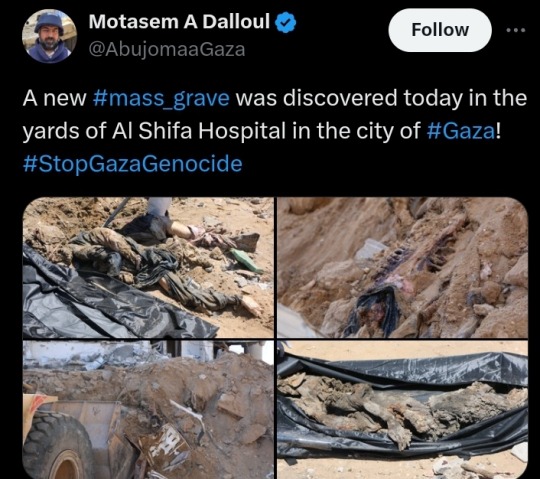

Over 400 people have been found in mass graves in Al Shifa Hospital and Nasser Hospital so far
#yemen#jerusalem#tel aviv#current events#palestine#free palestine#gaza#free gaza#news on gaza#palestine news#news update#war news#war on gaza#al shifa hospital#nasser hospital#gaza genocide#genocide#Dear bodies tw#Bodies tw#Corpses tw#edited
1K notes
·
View notes
Text
Live coverage of the 17th of January 2024 is now closed.
Here is a recap of today's major events.

It is 12am in Ireland now so I have to go to bed.
I'll be back to resume live updates on Sunday as I unfortunately have to work.
For continuous updates while I'm gone, click the link below:
#free gaza#free palestine#gaza strip#irish solidarity with palestine#palestine#gaza#news on gaza#al jazeera#boycott israel#israel#Rafah#iof terrorism#Medecins Sans Frontiers#Doctors Without Borders#Nasser Hospital#Khan Younis#Yemen#Houthis#Red Sea#Qatar#Hamas#West Bank#West Bank Palestinians#Tulkarem#Nablus#Summary#Recap#News updates#Current events#Goodnight
640 notes
·
View notes
Text
the end of bisan’s live from tonight, January 16th 2024. Please share, contact representatives, call for a ceasefire, don’t stop talking about Palestine!!! Call for a global strike January 21st!
#bisan#wizard bisan#Palestine#free Palestine#anti Israel#Israel#idf#fuck idf#fuck Israel#anti colonialism#anti Zionism#press#News#journalism#urgent#al-nasser hospital
400 notes
·
View notes
Text
Israeli attacks have damaged or destroyed:
• 380,000 housing units
• 412 schools and universities
• 556 mosques
• three churches
• 206 archeological and heritage sites
• knocked 32 hospitals and 53 health centres out of service
• 126 ambulances also targeted
All violations of the Geneva Convention
#NoOneAboveTheLaw
#palestine#palestinians#gaza#genocide#mass murder#mass graves#israeli apartheid#israeli occupation#idf terrorists#iof terrorism#right wing extremism#war crimes#justice#free palestine#free gaza#humanitarian crisis#settler colonialism#childrens holocaust#nasser hospital#al shifa hospital#rafah#us weapons#us complicity#biden administration#netanyahu#netanyahu the madman#annexation#land grab#state theft#geneva convention
236 notes
·
View notes
Text

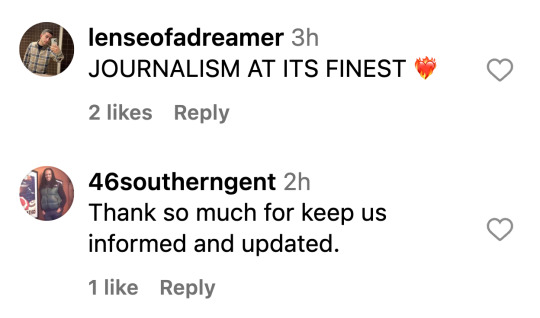
#nuseirat refugee camp#israeli raid#gaza massacre#eu condemnation#palestinian casualties#gaza health ministry#al-aqsa hospital#nasser hospital#doctors without borders#humanitarian crisis#gaza conflict#medical emergency#refugee camp attack#israeli-palestinian conflict#civilian casualties#health crisis#international outrage#idf operation#humanitarian aid#medical facilities overwhelmed#israel#west bank#international law#illegal occupation#palestine#human rights#israeli settlements#united nations#middle east conflict#international community
109 notes
·
View notes
Text
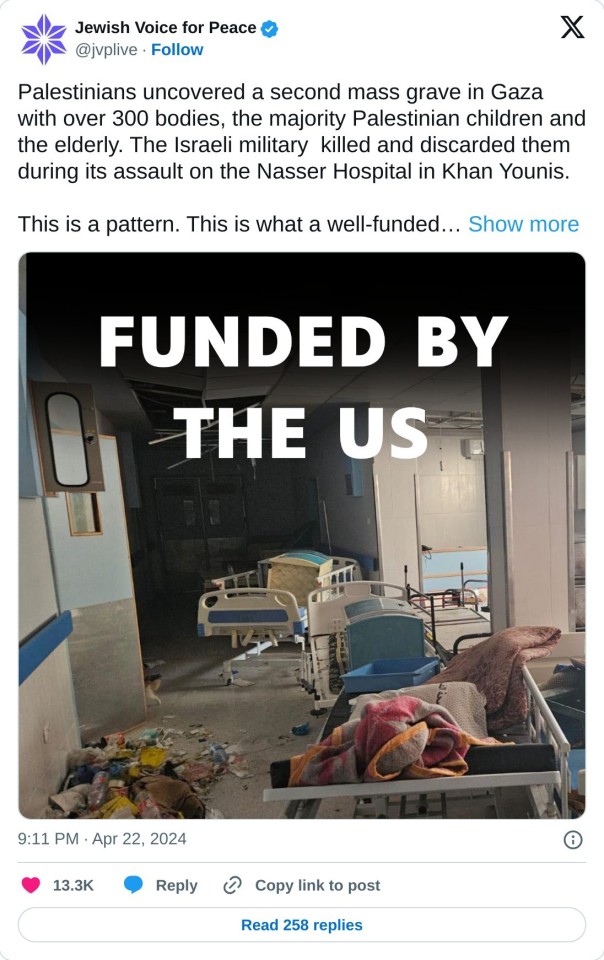
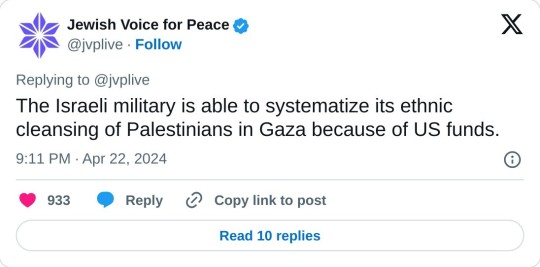



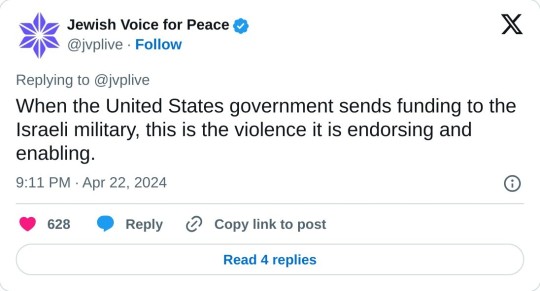

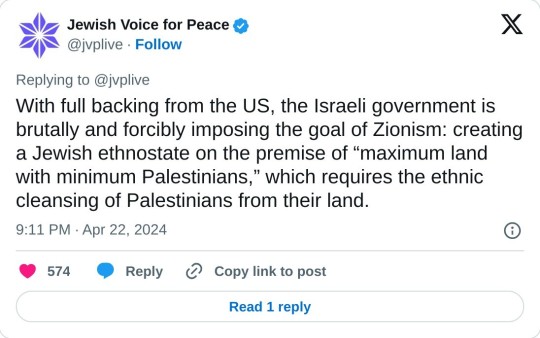
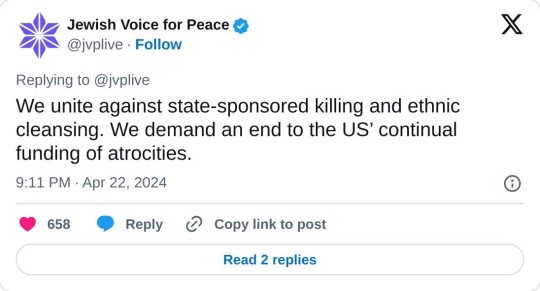

#feminist#social justice#free palestine#palestine#free gaza#current events#settler violence#settler colonialism#settler terrorism#us imperialism#western imperialism#zionist occupation#zionism is terrorism#united states#gaza hospital#nasser hospital#al shifa hospital#tw dead body#khan younis#end the occupation#gaza news#gaza strip#gaza#gaza genocide#jewish voice for peace
105 notes
·
View notes
Text
People are still saying, "but Hamas" "Oct 7th" "Israel has the right to defend itself" after the amount of mass graves discovered? MASS GRAVES?
This world is truly khalas.
sbeih.jpg
Al Jazeera
#palestine#free palestine#free gaza#free west bank#gaza#gaza strip#israel#genocide#social justice#human rights#al jazeera#palestine news#middle east#protest#save gaza#us politics#mass graves#nasser hospital#al shifa hospital
68 notes
·
View notes
Text
repost from @amnestyuk:
Last week, 179 healthcare workers from across the UK gathered outside St Thomas’ Hospital to demand freedom and justice for the 179 Palestinian healthcare workers who are detained without charge or trial by Israeli forces.
Among those in secret detention is Dr. Khaled Al Serr, who was taken in March this year from Nasser Hospital in Khan Younis. His family have yet to see him or hear from him.
These healthcare heroes should be saving lives, not facing torture or being criminalised. We urgently call on the UK government to demand the Israeli authorities reveal the whereabouts of these healthcare workers and release them immediately.
#palestine#human rights#free palestine#gaza#israel#free gaza#gaza genocide#healthcare#healthcare workers#doctors#Dr ghassan abu sittah#Dr khaled Al serr#palestinian hostages#palestinian genocide#the lancet#surgeon#doctor#israel is committing genocide#israel is a terrorist state#israeli war crimes#boycott israel#nasser hospital
36 notes
·
View notes
Text
by Stacey Mattews
The Biden White House has also said they want “answers”:
“We want answers,” National Security Advisor Jake Sullivan told reporters. “We want to see this thoroughly and transparently investigated.”
A spokesperson for the US State Department also said Washington was continuing to press Israel for more information.
As with most things claimed by a Hamas-run organization, the problem here is that the mass grave was actually dug in January 2024 – but not by the IDF:
Analyses by Sky News and independent analysts of satellite imagery and footage published online found that claims spread by Hamas and Arabic media that the IDF had dug mass graves at the Nasser hospital in Gaza were false as the graves were made before the IDF entered the complex.
Hamas, Al-Jazeera, and several news agencies claimed in recent days that the IDF had dug mass graves in order to “hide” the bodies of Palestinians after entering the Nasser hospital in Khan Yunis.
Here’s more from the Times of Israel:
The IDF, in its response, said that during its operation in the area of Nasser Hospital in recent months, troops examined corpses that had been buried by Palestinians on the medical center’s grounds, “as part of an effort to locate hostages.”
The military said it operated in a “targeted manner,” only where it had intelligence that Israeli hostages may have been buried.
GeoConfirmed also has a lengthy thread that includes receipts that back up Shoshani’s statement. Make sure to click on the tweets to expand them for more detailed explanations:
The tweets are here
#mass graves#hamas#hamas lies#gaza#media bias#al jazeera#idf#nasser hospital#khan yunis#sky news#media hoax
26 notes
·
View notes
Text
From Dr. Mohammed Ayman's stories Nasser Hospital lost power and a 10 year little girl died in intensive care as a result.
Nasser is still besieged and IOF snipers are still terrorising anyone that moves in the complex. In Khan Younis. While Rafah is being bombed to the south. Earlier today people were leaving Rafah city but going where I don't know because nowhere is safe. Deir al-Balah is still being bombed. North Gaza is still being attacked and starved. The entire strip is under attack in multiple ways.
This is ethnic cleansing and genocide funded and fully supported by the US, UK and other western powers. I know there's a sense of hopelessness about it all but we must be steadfast in calling for an end to these crimes and genocide.
#do what you can#dont stop talking about palestine#gaza#gaza city#deir al balah#khan younis#rafah#nasser hospital#current events#protest#boycott#email your reps#palestine#free palestine#end the genocide#end israels genocide#ceasefire now#free palestine until its backwards
34 notes
·
View notes